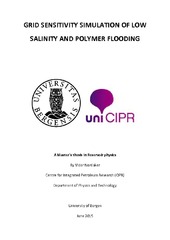| dc.contributor.author | Nordaker, Vidar | eng |
| dc.date.accessioned | 2015-08-24T14:43:25Z | |
| dc.date.available | 2015-08-24T14:43:25Z | |
| dc.date.issued | 2015-05-31 | |
| dc.date.submitted | 2015-05-31 | eng |
| dc.identifier.uri | https://hdl.handle.net/1956/10356 | |
| dc.description.abstract | Water flooding in a reservoir is a well- established recovery method used to maintain the reservoir pressure and to displace the oil towards the producing well. However, after water flooding there is still a substantial amount of oil left in the reservoir, often as much as 60%, leaving a vast recovery potential. By using Enhanced Oil Recovery methods (EOR) it is possible to produce this residual oil and increase our production significantly. Usually water flooding is used with normal seawater due to its availability, but since the late 1940`s, scientists have been looking at the chemistry of the injected water. Research (Jerauld et al., 2006) have shown that by reducing the salinity of the injection water could increase the recovery by 5-38 % . Several mechanisms for low-salinity injection have been proposed, but scientists have not yet reached a consensus regarding the main mechanism(s). The papers published on low-salinity recovery are mostly based on laboratory displacement experiments, and there are therefore few examples of reservoir modeling of low-salinity water flooding. This thesis is based on a laboratory experiment conducted at the Center for Integrated Petroleum Research (CIPR) at the University of Bergen. This thesis will focus on upscaling of the experiments to field-level in order to see how the low-salinity effects can affect a reservoir production. The reservoir rock has the properties of the Berea sandtone core sample presented in Gro Kallevik`s master`s thesis Implementations of Methods for Modelig Low Salinity Waterflood and Low Salinity Surfactant flooding". But other than that there are no specific geologic structures other than a difference in absolute permeability between the regions. The horizontal grid-sensitivity of the system and how it affects fluid flow, dispersion, and production will be emphasized in this study. | en_US |
| dc.format.extent | 8163651 bytes | eng |
| dc.format.mimetype | application/pdf | eng |
| dc.language.iso | eng | eng |
| dc.publisher | The University of Bergen | en_US |
| dc.rights | Copyright the Author. All rights reserved | eng |
| dc.subject | grid sensitivity | eng |
| dc.subject | Simulation | eng |
| dc.subject | low salinity | eng |
| dc.subject | grid sensitivity simulation | eng |
| dc.subject | Økt oljeutvinning | nob |
| dc.subject | Reservoarsimulering | nob |
| dc.title | Grid sensitivity simulation of low salinity and polymer flooding | en_US |
| dc.type | Master thesis | |
| dc.description.localcode | MAMN-PETR | |
| dc.description.localcode | PTEK399 | |
| dc.subject.realfagstermer | http://data.ub.uio.no/realfagstermer/c004024 | |
| dc.subject.realfagstermer | http://data.ub.uio.no/realfagstermer/c031431 | |
| dc.subject.nus | 752223 | eng |
| fs.subjectcode | PTEK399 | |
